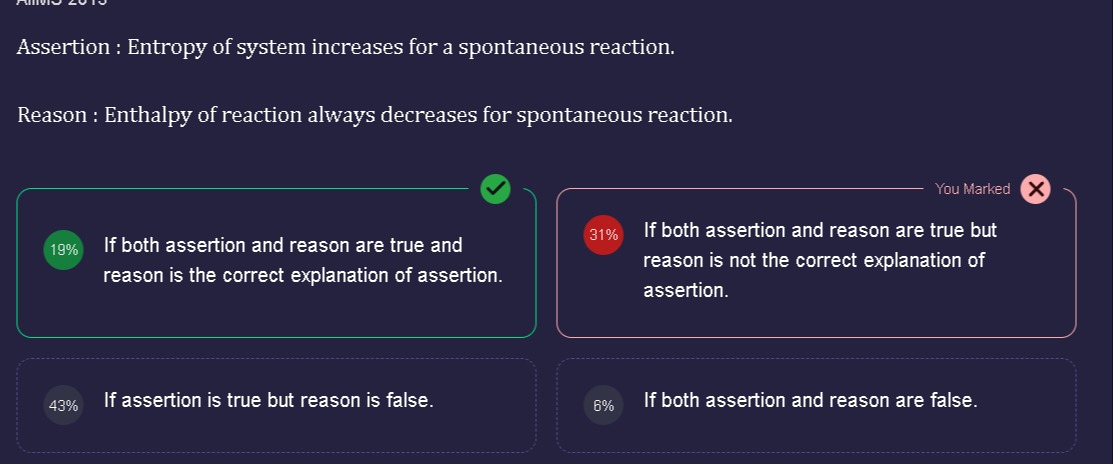Question
Question: Assertion: Entropy of system increases for a spontaneous reaction. Reason: Enthalpy of reaction alw...
Assertion: Entropy of system increases for a spontaneous reaction.
Reason: Enthalpy of reaction always decreases for spontaneous reaction.

If both assertion and reason are correct and the reason is a correct explanation of the assertion.
If both assertion and reason are correct but reason is not a correct explanation of the assertion.
If assertion is correct but reason is incorrect.
If both assertion and reason are false.
If both assertion and reason are false.
Solution
The question asks us to evaluate an assertion and a reason statement regarding spontaneous reactions and their thermodynamic parameters.
Assertion Analysis: "Entropy of system increases for a spontaneous reaction." This statement is false. According to the second law of thermodynamics, for a spontaneous process, the total entropy of the universe must increase (ΔS_universe > 0). This means ΔS_system + ΔS_surroundings > 0. However, it is not necessary for the entropy of the system (ΔS_system) to increase for a reaction to be spontaneous. A spontaneous reaction can occur even if the entropy of the system decreases (ΔS_system < 0), provided that the entropy of the surroundings increases by a greater magnitude (ΔS_surroundings > |ΔS_system|). A classic example is the freezing of water below 0°C:
H₂O(l) → H₂O(s)
This process is spontaneous at temperatures below 0°C, but the entropy of the system (water turning into a more ordered solid) decreases (ΔS_system < 0). The spontaneity arises because the process is exothermic (ΔH < 0), releasing heat to the surroundings and thus increasing the entropy of the surroundings sufficiently to make ΔS_universe positive.
Reason Analysis: "Enthalpy of reaction always decreases for spontaneous reaction." This statement is also false. While exothermic reactions (ΔH < 0) are often spontaneous, it is not a universal rule. Many spontaneous reactions are endothermic (ΔH > 0), meaning they absorb heat from the surroundings. These reactions are spontaneous because they lead to a significant increase in the entropy of the system (ΔS_system > 0). According to the Gibbs free energy equation:
ΔG = ΔH - TΔS_system
For a reaction to be spontaneous, ΔG must be negative (ΔG < 0). If ΔH > 0 (endothermic), the reaction can still be spontaneous if TΔS_system is sufficiently positive and larger than ΔH, making ΔG negative. Examples of spontaneous endothermic reactions include:
- Melting of ice above 0°C: H₂O(s) → H₂O(l) (ΔH > 0, ΔS_system > 0, spontaneous at T > 0°C).
- Dissolution of ammonium nitrate in water (used in instant cold packs): NH₄NO₃(s) + H₂O(l) → NH₄⁺(aq) + NO₃⁻(aq) (ΔH > 0, ΔS_system > 0, spontaneous at room temperature).
Conclusion: Both the Assertion and the Reason statements are false.
Spontaneity of a reaction is determined by the change in Gibbs free energy (ΔG), where ΔG = ΔH - TΔS_system. For a spontaneous reaction, ΔG must be negative.
- Assertion: "Entropy of system increases for a spontaneous reaction." This is false. A spontaneous reaction can have a decrease in system entropy (ΔS_system < 0), as long as the entropy increase in the surroundings (ΔS_surroundings) is larger, ensuring ΔS_universe > 0. Example: Freezing of water below 0°C.
- Reason: "Enthalpy of reaction always decreases for spontaneous reaction." This is false. Many spontaneous reactions are endothermic (ΔH > 0), provided there is a sufficient increase in system entropy (ΔS_system > 0) to make ΔG negative. Example: Melting of ice above 0°C or dissolution of ammonium nitrate.
